Steve’s Books
Please help to maintain this website by purchasing copies of my books via the links below. Any donations given to the website, or money earned via book sales, is used to continue research into Welsh war memorials and un-commemorated WW1 servicemen and women, and also helps keep all of this work online by helping to fund the website fees.
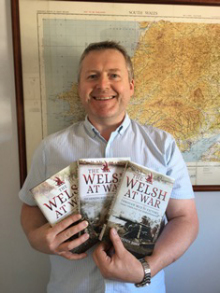
Steve was born and bred in Laugharne, in Carmarthenshire, and served his apprenticeship as an engineer with the Ministry of Defence at the Royal Aerospace Establishment, Aberporth. He now lives in Shropshire, still working in engineering. His interest in World War One led to him writing his first book on the Laugharne War Memorial and then resulted in the publication of his first book ‘Carmarthen Pals’ in 2009. Steve is also the author of: ‘Carmarthen in the Great War’ (2014), which tells the story of how the war affected the county of Carmarthenshire; ‘Welsh Yeomanry at War’ (Aug 2016), a History of the 24th (Pembroke and Glamorgan) Yeomanry Battalion, Welsh Regiment during the Great War; and the trilogy: ‘The Welsh at War’, the story of the Welsh units and other stories of Welsh interest during the Great War, all of which have been published by Pen and Sword Books, as well as the author of six other self-published books on local war memorials.
I possess a limited number of each of my books which can be personally signed by myself and posted directly. Books can be bought directly from myself via the Donate button at the top of the website, and leaving a note if you would like the book signed for yourself or for someone else. My self published books on local war memorials can be seen towards the bottom of this page, and can be purchased direct from the printers, as they are print to order.
Carmarthen Pals
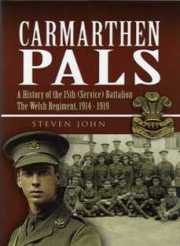
CLICK HERE TO BUY CARMARTHEN PALS
My first published book, ‘Carmarthen Pals’, tells the history of the 15th (Service) Battalion, Welsh Regiment, and was published by Pen and Sword Books. It is available through themselves, Amazon or at all good bookshops. For basic information on the Battalion, please see the relevant link on the Local Units page. I am still looking for anything related to the Battalion to continue my research into it, so would gratefully welcome copies of paperwork, photographs, memoirs etc. To purchase a copy of ‘Carmarthen Pals’ for £25, which includes P&P, please click on the Donate link above.
Carmarthen Pals Reviews
The 15th (Service Battalion), the Welsh Regiment, or the Carmarthen Pals, was one of the New Army battalions raised in Britain once it became clear that the First World War was going to last for longer and require a much bigger army than almost anyone had expected in the summer of 1914. This book looks at the history of that battalion from its original formation late in 1914, through some of the most famous battles of the war (including the Somme, Passchendaele and the hundred days offensive 1918) and ending when the battalion was dissolved in 1919.
Perhaps this books defining feature is that the author has taken the time to research the stories of a large number of the dead, so rather instead of the anonymous totals presented in many books here we often have a potted biography of at least some of each day’s dead.
This book makes one realise just how costly the final victorious campaigns of 1918 were. A single action on 8 October 1918 cost the battalion 53 dead, nearly 10% of the 570 dead suffered by the 15th Welsh during the entire war, and twice as many men died during 1918 as during 1916, when the battalion was involved in the battle of the Somme!
The appendices nicely round off the book, including complete lists of the battalion’s dead, medal winners (with citations where possible), and officers (with brief biographies).
This is an impressive sobering read, which stands as a memorial to the men of the 15th Welsh and the sacrifices they made during the Great War. (History of War Website)
Carmarthen in the Great War
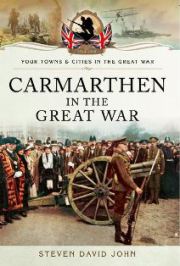
CLICK HERE TO BUY CARMARTHEN IN THE GREAT WAR
My book, ‘Carmarthen in the Great War’, was published in June 2014 by Pen & Sword Books. It is available for purchase through them directly, from Amazon, or from all good bookshops. The book tells of the contribution that the county made to the war effort; of some of the casualties suffered by the county; and of some stories on the home front during the four years of the war. To purchase a copy for £10, including P&P, please click on the Donate link above.
Carmarthen in the Great War Reviews
An extremely interesting and well-researched book chronicling the progress of the war and showing how it affected local communities in Carmarthenshire. A treasure trove of information for all families whose ancestors served in the Great War. (Dyfed Family History Society)
Welsh Yeomanry at War
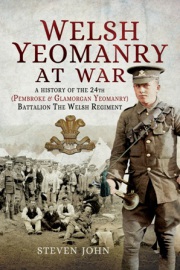
CLICK HERE TO BUY WELSH YEOMANRY AT WAR
My latest book, ‘Welsh Yeomanry at War’, has just been published on 30 November 2016. It tells the story of the 24th (Pembroke and Glamorgan Yeomanry) Battalion, Welsh Regiment during the Great War. It and covers the interesting history of this battalion during its campaign in Egypt, Syria, and Palestine, and also its move to France in 1918 to take part in the great offensive.
After many years of part time soldiering as cavalry troops on home defence duties, the members of the various British Yeomanry regiments were asked to volunteer for overseas service soon after the outbreak of war. Officered by many well known members of the landed gentry, two of the Welsh Yeomanry regiments, the Pembroke Yeomanry and the Glamorgan Yeomanry, were amongst many who embarked for foreign service for the first time in their history during 1916. Spending the coming twelve months in Egypt during the campaign against the Senussi tribesmen, the two regiments merged to form the 24th (Pembroke and Glamorgan Yeomanry) Battalion, Welsh Regiment, which joining the 74th (Yeomanry) Division to take part in the historic offensive into Palestine that ultimately led to the liberation of the Holy City of Jerusalem after 400 years of Ottoman rule. After two years of hard campaigning in the Palestinian deserts, the 24th Welsh embarked for France with the rest of the 74th Division in May 1918; joining the Allied forces in the ultimately victorious 100 days offensive against the Germans. Much of the story of this battalion relates to the almost forgotten campaign in Palestine, which saw many of its troops killed and buried in the Holy Land, and also covers it’s short but arduous period in France during the 100 days offensive.
To purchase a hardback copy of Welsh Yeomanry at War direct from the author for £20, including P&P, please click on the Donate link above.
Welsh Yeomanry at War Reviews
A masterpiece of exhaustive research, “Welsh Yeomanry at War: A History of the 24th (Pembroke and Glamorgan) Battalion The Welsh Regiment” is an impressively informative and exceptionally well written study. Featuring illustrations, three Appendices, a one page Select Bibliography, and a thirteen page Index, “Welsh Yeomanry at War” is an extraordinary and unreservedly recommended addition to both community and academic library 20th Century Military History collections. It should be noted for the personal reading lists of military history buffs that “Welsh Yeomanry at War” is also available in a paperback edition (9781473867932) and in a digital book format (Kindle). (Midwest Book Reviews).
The Welsh at War Trilogy
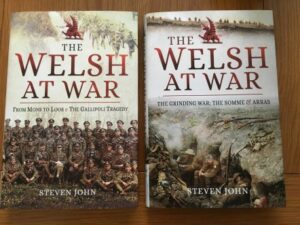
‘The Welsh at War’ trilogy are the latest books by Steven John and are the fruit of over twelve years of research by the author into the Welsh men and infantry units which fought in World War One. The book has ended up being too long for publication as it stands and has been edited down to be published in three parts.
These units included the three regular regiments; the Royal Welsh Fusiliers; South Wales Borderers and Welsh Regiment; as well as the Yeomanry regiments; the Denbighshire Hussars; Pembroke Yeomanry; Montgomeryshire Yeomanry; Glamorgan Yeomanry and Welsh Horse Yeomanry and their amalgamation into service battalions for the regular regiments during 1917.
Welsh troops fought with great courage in every theatre of the war: the Western Front; China; Gallipoli; Egypt; India; Salonika and in Palestine and as well as the casualties who were suffered during these campaigns, many men gained recognition for acts of gallantry.
The author has attempted to cover all of the major actions and incidents which each of the Welsh infantry units took part in, as well as covering other stories of national interest, ranging from Welshmen shot at dawn; Welsh rugby players; Welsh gallantry winners; and of some Welshmen who died in non-Welsh units; such as the Dominion forces and other units of the British armed forces, while chronicling a history of the war through the events and battles that Welshmen took part in. The stories of individual casualties are included as often as possible, together with many photographs of the men and their last resting places.
The Welsh at War, Volume 1
From Mons to Loos & the Gallipoli Tragedy
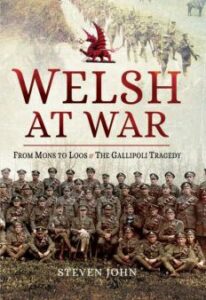
CLICK HERE TO BUY VOLUME I OF WELSH AT WAR
The Welsh at War, Volume 2
The Grinding War – The Somme and Arras
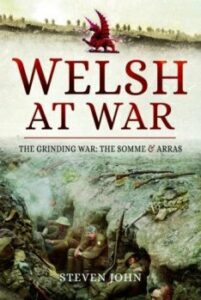
CLICK HERE TO BUY VOLUME II OF WELSH AT WAR
The Welsh at War, Volume 3
From Mud to Victory – Third Ypres and the 1918 Offensives
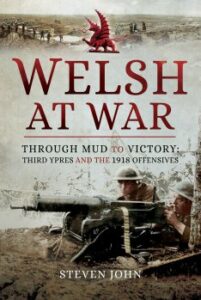
CLICK HERE TO BUY VOLUME III OF WELSH AT WAR
The Welsh at War Book Reviews
The first newspaper article about my Welsh at War Trilogy was printed in the Shropshire Star of 9 April 2018:
A nice review of volume 1 of Welsh at War has also appeared on Amazon and Waterstones:
The Welsh at War is the culmination of research into many of the Welsh Regiments in the First World War, by Steven John. This is one of the best researched military histories on the market today and covers the main regiments of Wales. This book covers the period from the opening of the War, with the Battles of Loo and Gallipoli, and the arrival of a Welsh Division in France in December 1915.
Opening with the outbreak of the War and the response in Wales in 1914, is a fascinating account of what happened. Which infantry units were mobilised first along with the members of Royal Naval Reserve making for their war stations.
I found interesting were the developments on the Home Front as well as the expansion of the Army. What is fascinating is the amounts of information he has gathered on the Auxiliary Hospitals that were set up in conjunction with the civilian one. In fact, it makes it simple he lists them per county, even though Anglesey has always been Yns Mon, but that is me showing off!
Throughout the book there are some fantastic maps and pictures, which help to bring this book to life and are an important addition. With some excellent commentary on the various battles throughout the book, helps to show the depth of knowledge and research that has gone in to this excellent book.
This is an excellent book for all those interested in the history of the First World War.
Another short review on Books Monthly:
This is as comprehensive a survey and history of Welsh involvement in the Great War as you could hope to have. Brilliant photographs and incredible human detail make this a must have for students of the greatest conflict the world has ever known.
Self Published Books on Local War Memorials
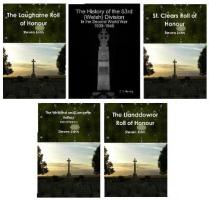
Click here to order any of Steve’s local War Memorial books
The Kidwelly Roll of Honour
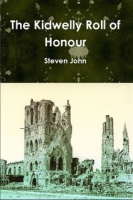
Kidwelly is an ancient town, sat in a prominent position overlooking the River Gwendraeth and Carmarthen Bay, at a position thought important enough by the Normans to build the impressive castle which still stands today. The book tells the stories behind the names of the men on the Kidwelly War Memorial who fell during both World Wars. Also included are the stories of some of the other local men who are not commemorated on the Kidwelly memorial. This second edition includes the additional details of the four men from Llansaint who have been added to the memorial. Click here to purchase the Kidwelly Roll of Honour
The Laugharne Roll of Honour
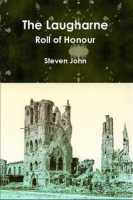
Sat in a picturesque location in South West Wales is the Ancient Township of Laugharne. Now best known for being the home and last resting place, of the Poet Dylan Thomas, at the turn of the 19th Century, Laugharne was a haven for the High Society, and for retired Army and Naval Officers. This small place gave up the flower of its youth to the Great War, and created its own small piece of history when William Fuller became the first Welshman to win the Victoria Cross during that great conflict. This book aims to remember the fallen of Laugharne for both World Wars, and contains short biographies of them all. This is an updated version of the original book, and contains details on several extra men who have been discovered as being from Laugharne, but who are not commemorated on the Laugharne War Memorial. Click here to purchase the Laugharne Roll of Honour
The Llanddowror Roll of Honour
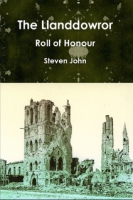
The Historical Village of Llanddowror lies in the County of Camarthenshire, in West Wales, and sits in a lovely position in the Valley of the River Tâf, astride the main A4077 into Pembrokeshire, just three miles from St. Clears. The Village was made famous for being the residence of Gruffydd Jones, the Father of the modern School system. This book commemorates the memory of all of the men of the Village of Llanddowror who served during the course of the Great War. Many of them were taught in the small School originally founded by Gruffydd Jones, and were not long out of School themselves when called to fight for King and Country, during the Great War. Click here to purchase the Llanddowror Roll of Honour
The Llansteffan and Llanybri Roll of Honour
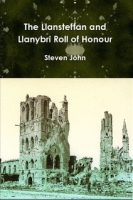
Llansteffan is a picturesque village which sits about seven miles south of Carmarthen, just above the junction of the Tâf and Tywi estuaries on the River Tywi. The village is overlooked by its fine 12th Century Norman Castle, and was once a thriving fishing community. The men of the village who fell during both World Wars are commemorated on two plaques which adorn the front of the village Memorial Hall. There is also a plaque within St. Steffan’s Church which commemorates four of its parishioners who fell during the Great War. The Llansteffan and Llanybri Roll of Honour contains the stories behind the names on the war memorials in the villages of Llansteffan and Llanybri. Click here to purchase the Llansteffan and Llanybri Roll of Honour
The St. Clears Roll of Honour
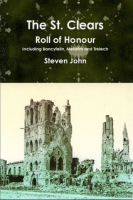
The small Town of St. Clears is situated in West Wales, in the County of Carmarthenshire. St. Clears sits between the River Tâf and the River Cynin, astride the main A40 into Pembrokeshire. This book commemorates the memory of the men of the Town who gave their lives during both World Wars of the Twentieth Century, and also two of the greatest Fighter Pilots to have flown with the Royal Air Force. Also included in the book are men from the neighbouring villages of Bancyfelin, Meidrim and Trelech who fell during both world wars. Click here to purchase the St. Clears Roll of Honour
The Whitland and Lampeter Velfrey Roll of Honour
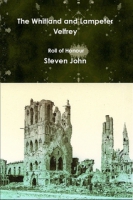
The ancient Town of Whitland sits in a pleasant part of West Wales, in the Valley of the River Tâf. It sits on the Borders of the old Counties of Pembrokeshire and Carmarthenshire, and is famous for being the meeting place of the first ‘Welsh Assembly’, led by Hywell Dda. The Town is mentioned in the ‘Mabinogion’ due to it’s historic Cistercian Abbey, and the link to Hywel Dda. This book commemorates the memory of the men of Whitland who fought and died in World War One and World War Two, and contains photos of many of the men, and of their last resting places. Click here to purchase the Whitland and Lampeter Velfrey Roll of Honour
The History of the 53rd (Welsh) Division, 1939-1955
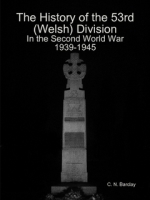
The 53rd (Welsh) Division was raised during the Great War, and served in the Middle East, through the disastrous campaign at Gallipoli, and during the successful campaign from Egypt that led to the capture of Jerusalem and the fall of the Ottoman Empire. This famous Division was to see further service during World War Two. After formation prior to the outbreak of War, they were based in Northern Ireland, where they helped stem the work of the I.R.A. They remained on Home Service until landing in Normandy at the end of June, 1944 and fought through the terrible fighting of the Bocage area of Normandy, up through Northern France, liberating Occupied Belgium and Holland and into German, where they played a vital, but un-commemorated part in the Battle of the Bulge. The Division ended the War at Hamburg, after a ferocious but successful campaign. The 53rd Division contained all of the Territorial Welsh units of WW2, and many Welshmen served and died as part of the Division.
This book is a reprint of the original 1956 printed version by C. N. Barclay, which is now unavailable, and is printed with beautiful glossy hardback covers, with an atmospheric shot of the 53rd (Welsh) Division Memorial at ‘s-Hertegenbosch, a large Dutch Town liberated by the Division in 1944.
Please click on the link below to order a copy of any of the above, or search for them on Amazon. Click here to purchase a copy of any of the above self-published books.
Website Links
This links section is a work in progress at the moment, but is intended to become a source of useful information for anyone interested in their military ancestors. I will be adding more to this list when time allows. If you need any advice researching a person or a memorial, please contact me before you go subscribing to any websites, as more often than not you do not need to pay out any money to research your military ancestors.
I’d like to show my support behind a project which is the brainchild of a friend and a former rugby coach at Laugharne, Andy Edwards, who with the backing of the Tin Shed boys are constructing a replica Great War trench complex at Pendine in order to give schoolchildren a bit of a taste of the war. Back to the Front Experience
One man who I cannot thank enough for taking photographs of the graves of local men in far off places such as Gallipoli, is Bob Pike. He is extremely helpful, and offers photographs of graves and memorials at a reasonable price. His e-mail is Bob Pike
The Western Front Association exists to spread the knowledge of the Great War, helping to remember the men that fought, and to help maintain memorials and sites of interest. The Western Front Association
The Commonwealth War Graves Commission Website is one of the best places to begin researching a member of the Commonwealth Armed Forces that died in both World Wars. Commonwealth War Graves Commission
If you need to research a soldier’s service, including getting hold of any surviving service papers, then I can recommend Jonathan Collins. He has carried out many searches for me in the past, and is 100% reliable. He is also a well regarded medal dealer. Jonathan Collins Military Research
Another man who I use for research is Steve Law, of Great War Medals. As the name suggests he is another well respected medal dealer. Great War Medals
Another site that I find most useful in researching the locations of Battalions and units in the Great War, where they fought, what Divisions they were part of etc is Chris Baker’s excellent Great War Website. The Long, Long Trail
The excellent Milford Trawlers website, created by Barry Johnson, is packed with information about the men and boats which sailed from Milford Haven, many of whom were lost at sea: Milford Trawlers
Dr. Reg Davies’ Welsh Mariners website is a fantastic resource for researching any Welshman who served in the Merchant Navy: Welsh Mariners
For anyone interested in the campaign in the Far East during World War Two, the the FEPOW website is crammed full of information: Far East POWs
A similar project to mine is the Flintshire War Memorials website, which is continuing to grow from strength to strength: Flintshire War Memorials
And another similar project in Anglesey: Anglesey War Memorials
Another website packed with information is Shaun McGuire’s website commemorating the men of Newport, Gwent who fell. Shaun also has links on his website to another of his commemorating the men of Cwmbran, and another for the men of the villages of Monmouthshire: Newport War Memorials
A Nationally run website which is gathering together photographs and stories from all manners of Welsh History is the Peoples Collection Wales resource: Peoples Collection Wales
Thousands of men and women died in the service of Britain and the Commonwealth during two world wars and yet there is no official recognition of their sacrifice.
The In From The Cold Project (IFCP) was formed to research and identify all service men and women missing from the official Commonwealth War Graves Commission (CWGC) list of casualties from the First and Second World Wars. We are determined to get these soldiers, sailors and airmen their due recognition – even after the passing of so many years.
Unfortunately, a large number of names were missed from the lists supplied to the Commission and, as a result, many casualties have no official commemoration. Record keeping was not always as accurate as it should have been back in the pre-computer days of the early twentieth century. With modern technology and greater accessibility to remaining records, it is possible through painstaking and often tedious research to find many of these missing names and to gather the supporting evidence required for recognition by CWGC and the appropriate military authorities: In From the Cold Project
A fantastic project, which has enabled people like myself to find it much easier to carry out research on the impact the Great War had on Wales, is the Cymru 1914 project. Taken from their own description of the website: ‘This project has conducted mass digitization of primary sources relating to the First World War from the Libraries, Special Collections and Archives of Wales. The project will make available a coherent, consolidated digital collection revealing the often hidden history of the First World War as it impacted all aspects of Welsh life, language and culture. This digital archive brings together source materials that were previously fragmented and frequently inaccessible. This digital archive is a unique resource of vital interest to researchers, students, and the public in Wales and beyond.’ Cymru 1914
As unlikely as it seems, the town of Bedford became home to countless numbers of Welsh troops at various times during the Great War, and was also the final training area for the 53rd (Welsh) Division before it embarked for overseas service in 1915. To commemorate its links with the Welsh, a new website has been set up which is packed with stories and photographs relating to this: When The Welsh Came to Bedford